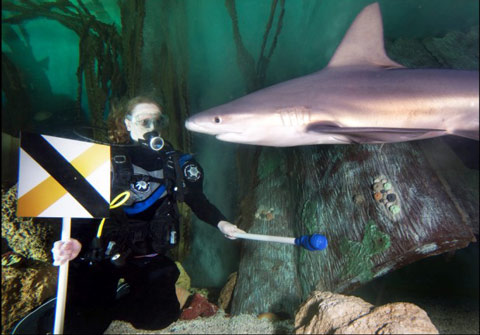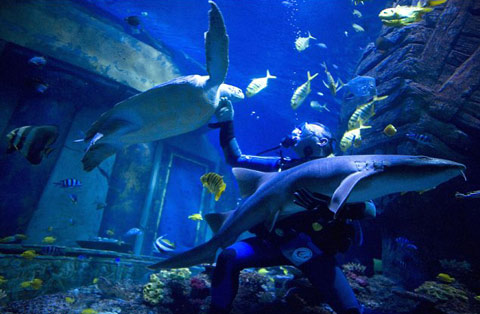Catching a shark must be
The Aquatic Center in the UK is training dolphin-like sharks in the hope of reducing the 'aggressive' level of this predator.
The brave officers of the oceanographic area began using shark training methods after seeing them respond well to this process. They are entering intensive training using the same color schemes and sounds that the scientist Ivan Pavlov applies to his dogs.

Staff are training sharks with signs and sounds.
Sharks receive signals through sight, hearing and reach the person holding the board. After that, sharks rub their nose against the board until they are fed. This means that the feeding process will be easier because they know when it's their turn. According to research by American scientists, the 'smart' shark will acquire this command after three months of training.

This training will help employees become more exposed to sharks.
Carey Duckhouse, a center specialist, said: 'American scientists have shown that a lot of sharks can quickly learn both signals by image and sound. Advances in shark care have a great significance. We have to move them when they are overgrown by the size of the tank or when the center needs refurbishment and their 'easier maintenance' will facilitate the movement. '
In addition, the training process will enable scientists to conduct routine health checks for sharks and treat them, without resorting to the same types of shark traps or anesthetics. 'We have a hook and we'll use it whenever we want to feed the sharks' , Carey Duckhouse said funnyly.
- The heartbreaking truth behind the shark's soup
- Catching tiger shark weighs nearly 400kg
- Catching a wide mouth shark is rare in the Philippines
- Catch an extremely rare 'alien' shark
- Big sharks eat small sharks
- Catching a 6-bearing shark originating before dinosaurs
- Indonesia and India kill the most sharks in the world
- The first shark in history to know ... vegetarian but still healthy
- Sharks are sliced with meat and fins in Indonesia
- Catching the biggest 'monster' shark in England, could not pull on the boat
- Catch sharks from prehistoric times
- Install a super-sensitive camera on the shark's body
 Surprised: Fish that live in the dark ocean still see colors
Surprised: Fish that live in the dark ocean still see colors Japan suddenly caught the creature that caused the earthquake in the legend
Japan suddenly caught the creature that caused the earthquake in the legend A series of gray whale carcasses washed ashore on California's coast
A series of gray whale carcasses washed ashore on California's coast Compare the size of shark species in the world
Compare the size of shark species in the world